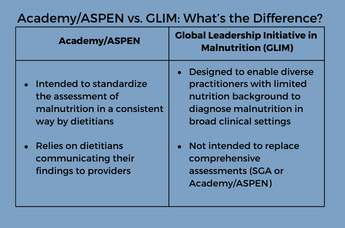Audit-Proof Your Malnutrition Documentation: An Interdisciplinary Approach
In the world of medical coding, payer denials are a fact of life. The Association of Clinical Documentation Integrity Specialists (ACDIS) recently shared that malnutrition is among the top three most-denied diagnoses (surpassed only by sepsis and respiratory failure). As they point out in their Clinical Validation and Denials Management Council Report, all these conditions can be supported by multiple criteria sets — like GLIM and ASPEN, in the case of malnutrition.
 Unfortunately, there is no universal definition of malnutrition that definitively translates to an ICD-10 code — and that means payers may “cherry-pick” criteria from different frameworks to support denials. While this challenge isn’t going away any time soon, there are ways to prepare your teams for audits and minimize denials. We’ve gathered up a few places to start.
Unfortunately, there is no universal definition of malnutrition that definitively translates to an ICD-10 code — and that means payers may “cherry-pick” criteria from different frameworks to support denials. While this challenge isn’t going away any time soon, there are ways to prepare your teams for audits and minimize denials. We’ve gathered up a few places to start.
1. Align Your Cross-Functional Teams on Academy/ASPEN Criteria
We begin with a focus on consistency. If your medical and CDI team members are using different criteria — or even using the same criteria with varying levels of rigor or specificity — you may have a difficult time justifying your diagnoses. So the first step is to gather your medical and CDI teams to align on one criteria to use, and train on how to use it most effectively. (In fact, training is so important that we’ll come back to it later in this list.)
2. Formalize and Document Your Policy
Once your medical and CDI teams are aligned and consistently using the criteria, it’s time to codify it and get approval from your Medical Review Committee (or local equivalent). By documenting your criteria, including the rationale and approvals behind those decisions, you will be in a strong position if (ok, when) you receive a query or denial from a payer.
Remember: do not change your clinical practices or definitions with the goal of aligning with payers. They may reference different criteria to question your diagnoses — but if you can point to a documented procedure that is followed consistently and has been properly validated, you can proceed with confidence
3. Document Your Interventions
“If it’s not documented, it didn’t happen.” – Every regulatory agency inspector ever*
In addition to documenting findings of malnutrition and the appropriate severity level, it’s important to list all treatments and interventions to address the issue — regardless of who ordered them. This should include monitoring and follow-up plans to ensure your reimbursements reflect the level of care and length of stay required to treat the malnourished patient.
4. Train and Assess Competencies Annually
Regular training is essential for both new hires and long-term team members. Growing workloads and frequently changing regulations can lead to inconsistency on even the best-managed teams. Training should include:
* Roles and responsibilities
* Workflows from screening through coding
* Nutrition-focused physical exam
5. Open the Lines of Communication Between Medical Providers
Dietitians cannot diagnose malnutrition. Physicians don’t always recognize the signs and symptoms. Coders may be ill-equipped to spot and query every finding of malnutrition after the fact. Relieve the burden on your CDI teams and streamline your nutrition care workflows by facilitating communication between medical providers.
Automated EHR workflows can go a long way here. Solutions like our MalnutritionCDS™ app make it easy for dietitians to document findings of malnutrition in the EHR, triggering the proper physician workflows in real time — with proper communication and documentation happening along each step of the process.
6. Automate Your EHR Workflows (With a Little Help from IS)
A technology-supported process can help prevent misses and streamline clinical validation. For example, when a dietitian documents findings consistent with malnutrition in the patient record, the physician can be flagged to review and make the diagnosis as appropriate. When your team can rely on easy-to-access technology to automate these processes for them, they can be confident they won’t miss a step. Ask your IS/IT team for help connecting the right applications to your EHR.
7. Ask an Informaticist to Check Your Terminology
When it comes to data interoperability and quality reporting, words matter. Reach out to nutrition informatics experts to ensure your terminology (eNCPT, SNOMED, LOINC) can be appropriately mapped. Not only can it help you avoid denials — it can also help you support consistent and structured data management to help track the clinical effectiveness of nutrition interventions.
Unfortunately, payer denials for malnutrition aren’t likely to go away any time soon. But with sound protocols, regular training and a little help from technology, you can spend less time worrying about them, and more time caring for your patients. We’re here to help. Get to know our MalnutritionCDS™ solution then reach out to explore how we can help you elevate clinical nutrition and drive results at your hospital.
